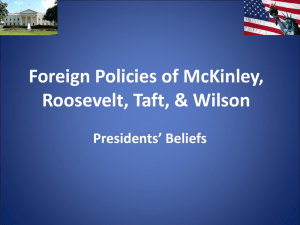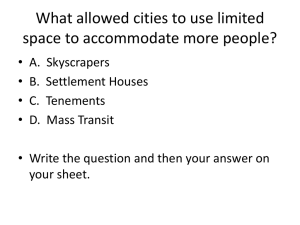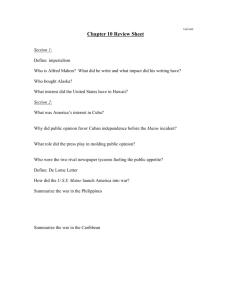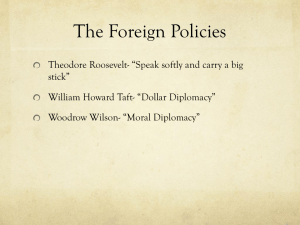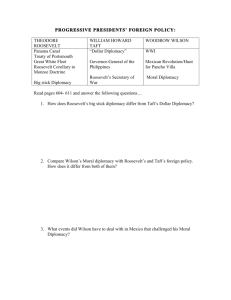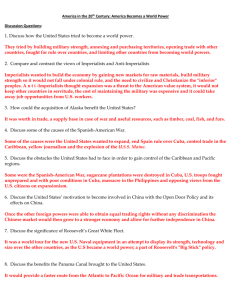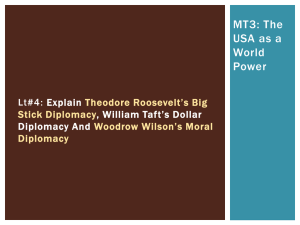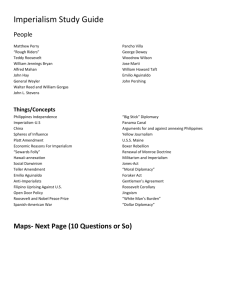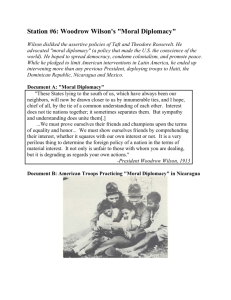Presidential Diplomacy
advertisement
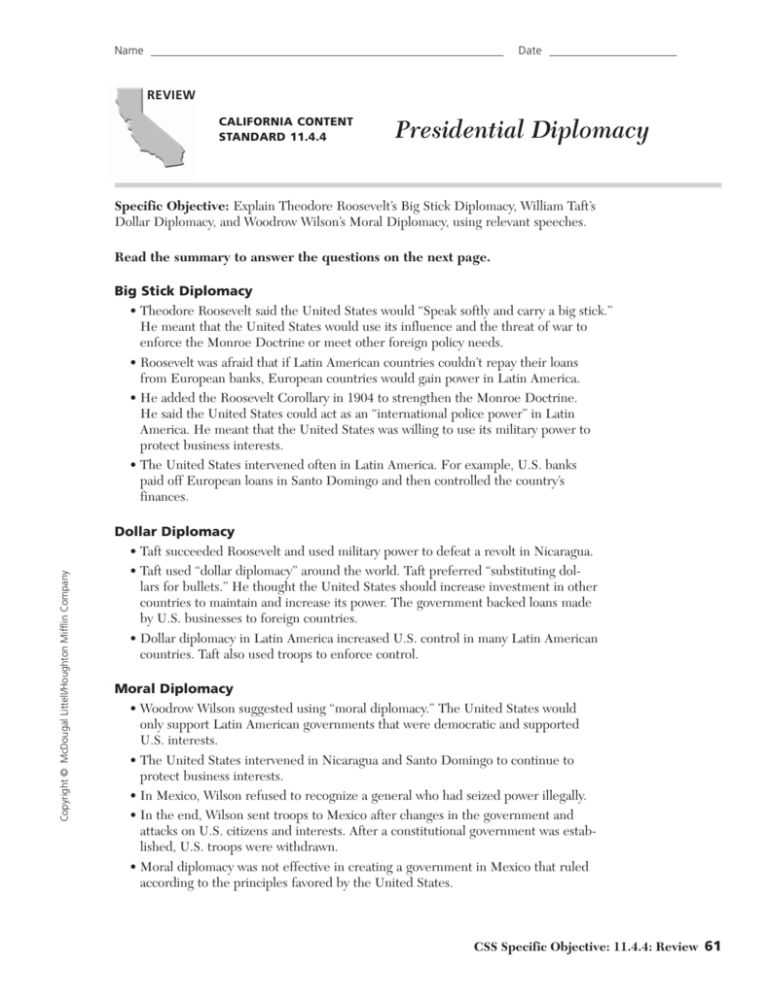
Name Date REVIEW CALIFORNIA CONTENT STANDARD 11.4.4 Presidential Diplomacy Specific Objective: Explain Theodore Roosevelt’s Big Stick Diplomacy, William Taft’s Dollar Diplomacy, and Woodrow Wilson’s Moral Diplomacy, using relevant speeches. Read the summary to answer the questions on the next page. Copyright © McDougal Littell/Houghton Mifflin Company Big Stick Diplomacy • Theodore Roosevelt said the United States would “Speak softly and carry a big stick.” He meant that the United States would use its influence and the threat of war to enforce the Monroe Doctrine or meet other foreign policy needs. • Roosevelt was afraid that if Latin American countries couldn’t repay their loans from European banks, European countries would gain power in Latin America. • He added the Roosevelt Corollary in 1904 to strengthen the Monroe Doctrine. He said the United States could act as an “international police power” in Latin America. He meant that the United States was willing to use its military power to protect business interests. • The United States intervened often in Latin America. For example, U.S. banks paid off European loans in Santo Domingo and then controlled the country’s finances. Dollar Diplomacy • Taft succeeded Roosevelt and used military power to defeat a revolt in Nicaragua. • Taft used “dollar diplomacy” around the world. Taft preferred “substituting dollars for bullets.” He thought the United States should increase investment in other countries to maintain and increase its power. The government backed loans made by U.S. businesses to foreign countries. • Dollar diplomacy in Latin America increased U.S. control in many Latin American countries. Taft also used troops to enforce control. Moral Diplomacy • Woodrow Wilson suggested using “moral diplomacy.” The United States would only support Latin American governments that were democratic and supported U.S. interests. • The United States intervened in Nicaragua and Santo Domingo to continue to protect business interests. • In Mexico, Wilson refused to recognize a general who had seized power illegally. • In the end, Wilson sent troops to Mexico after changes in the government and attacks on U.S. citizens and interests. After a constitutional government was established, U.S. troops were withdrawn. • Moral diplomacy was not effective in creating a government in Mexico that ruled according to the principles favored by the United States. CSS Specific Objective: 11.4.4: Review 61 Name Date U S InPRACTICE te re s ts in th e C a rib b e a n a s a n _ 0 5 1 8 tt_ 0 1 _ e CONTENT CALIFORNIA S e c .3 11.4.4 U n it 5 C h .1 8STANDARD w :3 9 p 9 h :2 3 p F in a l p ro o f 1 /4 /0 2 Presidential Diplomacy Directions: Choose the letter of the best answer. The United States in the Caribbean UNITED STATES U.S. and possessions Occupied by or protectorate of the U.S. Gulf of Mexico BAHAMA ISLANDS N Havana S MEXICO Guantánamo U.S. Naval Base CUBA Veracruz Occupied, 1914 JAMAICA HAITI BELIZE Protectorate 1915-1936 Occupied 1915-1934 HONDURAS PA C I F I C OCEAN 0 250 0 1 250 GUATEMALA EL SALVADOR PANAMA CANAL ZONE PUERTO RICO Annexed 1898 CARIBBEAN SEA Leased from Panama 1903 NICARAGUA Occupied 1912-1925 1926-1933 COSTA RICA 500 miles 500 kilometers DOMINICAN REPUBLIC Protectorate 1905-1941 Occupied 1916-1924 Protectorate 1898-1934 Occupied 1898-1902, 1906-1909, 1912, 1917, 1922 VENEZUELA PANAMA COLOMBIA Protectorate 1903-1939 How does the map reflect American foreign policy in the Caribbean? 2 Which theme was common to the diplomatic policies of presidents Roosevelt, Taft, and Wilson? A The United States took a hands-off policy toward the Caribbean. A B The United States wanted European countries to get involved in the Caribbean. They protected U.S. business interests. B They only supported countries with democratic governments. C The United States controlled several countries in the Caribbean. C They would not use U.S. troops. D They refused to back foreign loans. D The United States was only involved with Caribbean countries as a trading partner. 62 CSS Specific Objective: 11.4.4: Practice 3 President Wilson’s moral diplomacy was tested by conflicts in A Brazil. B Colombia. C Mexico. D Panama. Copyright © McDougal Littell/Houghton Mifflin Company E W AT LANTIC OCEAN US History Name: ____________________________ Block: _________ Measurement Topic 3: The USA becomes a World Power Level 3 Learning target #3: Explain Theodore Roosevelt’s Big Stick Diplomacy, William Taft’s Dollar Diplomacy and Woodrow Wilson’s Moral Diplomacy Directions: Read the handout, and power point notes to answer the following questions in complete sentences to receive full credit. 1. What was the main goal of Roosevelt’s big stick diplomacy? 2. What was Roosevelt’s Corollary? 3. Whose debt did the USA pay off? How did the USA collect the money to pay off the debt? 4. Do you think Roosevelt’s big stick diplomacy was a good policy? Why or why not 5. What was the main goal of Taft’s dollar diplomacy? 6. Why should the USA invest money in other countries, according to Taft? 7. Do you think Dollar Diplomacy was a good policy (plan)? Why or why not? 8. What was the main goal of Wilson’s moral diplomacy? 9. Why did Wilson intervene in the Mexican revolution? Write an essay were you compare and contrast the three policies (Theodore Roosevelt’s Big Stick Diplomacy, William Taft’s Dollar Diplomacy and Woodrow Wilson’s Moral Diplomacy)
